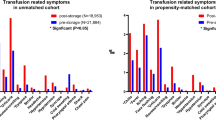Summary
Historically, ABO compatibility between donor and recipicnt has been considered of minor importance for platelet transfusion. However, in a recent ran-domized trial we showed that provision of only ABO-identical platelets was associated with a significantly higher corrected count increment (CCI) in the early transfusions and with a twofold reduction in refractoriness, as compared with platelets given unmatched for ABO. In older studies this phenomenon was not observed. We wondered whether in these previous studies the use of the conventional term “ABO compatible,” whereby ABO-identical platelet transfusions are grouped with those that are merely ABO compatible, might have obscured the advantages of the ABO-identical platelets. In this paper the CCI from our original study are compared with what would have been found had the conventional terminology of “ABO compatible” and “ABO incompatible” been used. In our original study the mean CCI in patients receiving only ABO-identical platelets was 64% higher than that achicved with ABO-unmatched products. However, when the transfusions were reanalyzed according to conventional terminology of ABO “compatible” and “incompatible,” the actual benefits of ABO-identical platelets were no longer detected. Thus, ha dwe used the conventional terminology in the original study we would have come to completely different conclusions about the importance of ABO in platelet transfusion. We hypothesize that transfusion of ABO-incompatible plasma leads to the formation of immune complexes that can destroy compatible platelets by indirect mechanisms. This model predicts that the success of a transfusion could be affected by previous incompatible transfusions. When transfusions were classificd as to whether they were first, second, or third unmatched transfusion, increasing numbers of transfusions of ABO-incompatible plasma were associated with progressively poorer mean increments. The same was true for platelet ABO-incompatible transfusions. In contrast, increasing numbers of ABO-identical transfusions were not associated with poorer increments. The failure to appreciate that (a) transfusions containing ABO-incompatible plasma yield poor increments and (b) the effects of ABO-nonidentical transfusions are cumulative, and therefore affect the success of subsequent identical transfusions, may have led in the past to the incorrect conclusion that ABO matching was of minor importance in repetitively transfused patients.
Similar content being viewed by others
References
Carr R, Hutton JL, Jenkins JA, Lucas GF, Ammphlett NW (1990) Transfusion of ABO-mismatched platelets leads to early platelet refractoriness. Br J Haematol 75: 408–413
Duquesnoy RJ, Anderson AJ, Tomasulo PA, Aster RH (1979) ABO compatibility and platelet transfusions of alloimmunized thrombocytopenic patients. Blood 54: 595–599
Es J Van, Thomas D, Olivos B (1978) Platelet use in pediatric oncology: a revicw of 393 transfusions. Transfusion 18: 169–173
Heal JM, Blumberg N, Masel D (1987) An evaluation of crossmatching, HLA and ABO matching for platelet transfusions to refractory patients. Blood 70: 23–30
Heal JM, Mullin A, Blumberg N (1989) The importance of ABH antigens in platelet cross-matching. Transfusion 29: 514–520
Heal JM, Rowe JM, McMican A, Masel D, Finke K, Blumberg N (1993) The role of ABO matching in platelet transfusion. Eur J Haematol (in press)
Lee EJ, Schiffer CA (1989) ABO compatibility can influence the results of platelet transfusion. Results of a randomized trial. Transfusion 29: 384–385
Lohrmann HP, Bull MI, Decter JA, Yankee RA, Graw RG (1974) Platelet transfusions from HL-A-compatible unrelated donors to alloimmunized patients. Ann Intern Med 80: 9–11
McFarland JG, Anderson AJ, Slichter SJ (1989) Factors influencing the transfusion response to HLA-selected apheresis donor platelets in patients refractory to random platelet concentrates. Br J Haematol 73: 380–386
NIH Consensus Development Conference (1986) Platelet transfusion therapy. NIH, Bethesda, MD
Schiffer CA, Lichtenfeld JL, Wiernik PH, Mardiney MR, Mehsen JJ (1976) Antibody response in patients with acute nonlymphocytic leukemia. Cancer 37: 2177–2182
Snedicor G, Cochran W (1980) Statistical methods. Iowa State University Press, Ames, IA
Tosato G, Applebaum FR, Deisseroth AB (1978) HLA-matched platelet transfusion therapy of severe aplastic anemia. Blood 52: 846–854
Walsh CM, Nardi MA, Karpatkin S (1986) On the mechanism of thrombocytopenia in patients at risk for acquired immuno-deficiency syndrome. J Clin Invest 77: 1756–1760
Author information
Authors and Affiliations
Additional information
Supported in part by funds from The American Red Cross
Rights and permissions
About this article
Cite this article
Heal, J.M., Rowe, J.M. & Blumberg, N. ABO and platelet transfusion revisited. Ann Hematol 66, 309–314 (1993). https://doi.org/10.1007/BF01695973
Received:
Accepted:
Issue Date:
DOI: https://doi.org/10.1007/BF01695973




